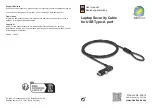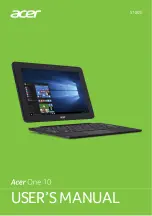
22 -
Quick Start & Troubleshooting Guide
Cable
A cable connection provides fast and ‘always-on’ Internet service via a cable television line. This service is generally
available in large cities. You can use your telephone and watch cable TV at the same time you are connected to the
Internet.
3G (WWAN or 'Wireless Wide-Area Network')
A 3G connection allows you to use cellular networks (such as those used by a mobile phone) to connect to the
Internet while away from home. The socket for a SIM card may be built in to your computer, or may require an
external device, such as a USB modem or even an appropriately equipped mobile phone.
Note:
If your computer includes a SIM card slot, you require a compatible SIM card and a contract with a
cellular provider.
Before using the 3G features, check with your service provider to see if any additional charges will be incurred,
especially roaming charges.
Network connections
A LAN (Local Area Network) is a group of computers (for example, within an office building or home) that share a
common communications line and resources. When you set up a network, you can share files, peripheral devices
(such as a printer) and an Internet connection. You can set up a LAN using wired technologies (such as Ethernet) or
wireless technologies (such as WiFi or Bluetooth).
Wireless networks
A wireless LAN or WLAN is a wireless local area network, which may link two or more computers without using wires.
Setting up a wireless network is easy and allows you to share files, peripheral devices and an Internet connection.
Note:
More detailed information is available in the InfoCentre wireless networks tutorial.
What are Benefits of a Wireless Network?
Mobility
Wireless LAN systems allow you and other users of your home network to share access to files and devices
connected to the network, for example a printer or scanner.
Also you can share an internet connection with other computers in your home.
Installation Speed and Simplicity
Installing a wireless LAN system can be fast and easy and eliminates the need to pull cables through walls and
ceilings.
Components of a Wireless LAN
To set up your Wireless network at home you need to have the following:
Access point (router)
Access points (routers) are two-way transceivers that broadcast data into the surrounding environment. Access
points act as a mediator between wired and wireless network. Most routers have a built-in DSL modem that will
allow you access to a high speed DSL internet connection. The ISP (Internet Service Provider) you have chosen
normally supplies a modem/router with the subscription to their services. Read carefully the documentation
supplied with your Access point/router for detailed setup instructions.
Network Cable (RJ45)
A network cable (also called RJ45 cable) is used to connect the host computer to the access point (see illustration
below); this type of cable may also be used to connect peripheral devices to the access point.
















































